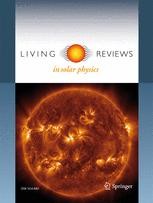Living Reviews in Solar Physics: "The Sun’s supergranulation"
 Rincon, F. & Rieutord, M., The Sun’s supergranulation, Living Rev Sol Phys (2018) 15: 6. https://doi.org/10.1007/s41116-018-0013-5
Rincon, F. & Rieutord, M., The Sun’s supergranulation, Living Rev Sol Phys (2018) 15: 6. https://doi.org/10.1007/s41116-018-0013-5
Open Access | Review Article
First Online: 10 September 2018
Major revision, updated and expanded. Switched author order. About 40 new references.
This new text represents a major update of our 2010 review on supergranulation. It is more readable and significantly more concise than the original publication in our view, yet (hopefully) addresses the many exciting theoretical, numerical and observational developments on the problem since 2010. All sections have been revised in a holistic way in the light of these new results. The general discussion has also been almost entirely rewritten to reflect recent evolutions in the understanding and perception of supergranulation in the broader solar dynamics context.
Abstract:
Supergranulation is a fluid-dynamical phenomenon taking place in the solar photosphere, primarily detected in the form of a vigorous cellular flow pattern with a typical horizontal scale of approximately 30–35 Mm, a dynamical evolution time of 24–48 h, a strong 300–400 m/s (rms) horizontal flow component and a much weaker 20–30 m/s vertical component. Supergranulation was discovered more than 60 years ago, however, explaining its physical origin and most important observational characteristics has proven extremely challenging ever since, as a result of the intrinsic multiscale, nonlinear dynamical complexity of the problem concurring with strong observational and computational limitations. Key progress on this problem is now taking place with the advent of twenty-first-century supercomputing resources and the availability of global observations of the dynamics of the solar surface with high spatial and temporal resolutions. This article provides an exhaustive review of observational, numerical and theoretical research on supergranulation, and discusses the current status of our understanding of its origin and dynamics, most importantly in terms of large-scale nonlinear thermal convection, in the light of a selection of recent findings.
The authors:
François Rincon and Michel Rieutord are members of the CNRS research staff at the Research Institute in Astrophysics and Planetology (IRAP), University of Toulouse, France.
François Rincon is working on astrophysical fluid dynamics, turbulence in fluids and plasmas, dynamo theory, solar and stellar physics, transport in accretion disks and galaxy clusters.
Michel Rieutord is an expert in rotating fluids and rotating stars; he is investigating convection of the Sun and in solar-like stars. He is the author of a highly successful textbook on "Fluid Dynamics" (Springer 2015).
